Applique is an ancient method of developing children of all ages, which includes a huge number of varieties: from geometric shapes, from fabric, from natural materials, subject, plot, decorative, and so on.
Benefits of applique classes for children of all ages
Application classes will bring an exclusively positive contribution to the child’s development:
- By engaging in this kind of activity, a person learns perseverance, diligence, and accuracy from an early age.. This fact is due to long-term work with small, fragile parts. Younger children, 3-5 years old, learn to handle not only the components of the craft, but also dangerous objects - scissors, glue. Older children, from 5 years old, get used to being careful in their actions, since most parts of the appliques, if handled carelessly, tear, get dirty, and become unsuitable for further use.
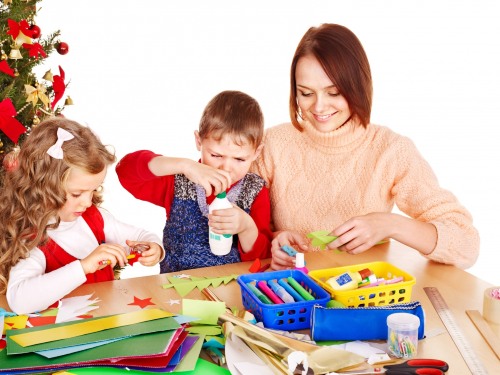
- Little ones who are just beginning their “path of creativity” by gluing bright, large pictures onto a surface, learn geometric shapes, colors, animals and so on.
- The fact of development of fine motor skills, creative thinking, and intelligence is indisputable in children of all ages when doing appliques. Improvement of motor skills is due to the work of students, forcing them to deal with small parts that differ by touch, in their working characteristics. Performing more complex tasks with composing a story, using the proposed objects as characters in a fairy tale (from 5 years old) or learning new information (from 3-5 years old), children definitely develop the hemispheres of the brain responsible not only for logic, but also for the creative component.
- Involving your child's friends and relatives in applique activities gives the little person his first idea of collective work. In the situation with little children (3-5 years old), third-party participants in the process will become a kind of active assistants, teachers, guiding him in his creative endeavor. Partners of older children (from 5 years old) will be more like colleagues, cooperation with whom will make the child's work more correct, more beautiful, in the case of gluing a story - more interesting.
- While doing appliques with a child, a parent thus lays the foundations of design thinking for him (it is necessary to assemble a whole from parts), helps to build cause-and-effect relationships in work discipline (to achieve a high-quality result, it is necessary to carefully cut out the figures, apply the required amount of glue, carefully place them in a specific place, let them dry; if you use more glue than necessary, it will spread during gluing of the part, and so on).
Preparing the workplace and materials
Whether it's a simple geometric shape applique or gluing a long story using the data provided, Due attention must be paid, first of all, to the organization of the child's workplace:
- It is important to make sure that the place where you are studying is safe.. It is worth removing from the table all unnecessary things that can distract the attention of the little person. It is advisable to cover the table with oilcloth or newspapers to avoid damaging it, for example, with glue. It is advisable to prudently dress the young creator in home clothes due to the high probability of damaging things with "tools".
- It is necessary to prepare everything necessary for the application in advance., so that during work you don’t experience discomfort due to the need to unexpectedly take out, finish drawing, etc.
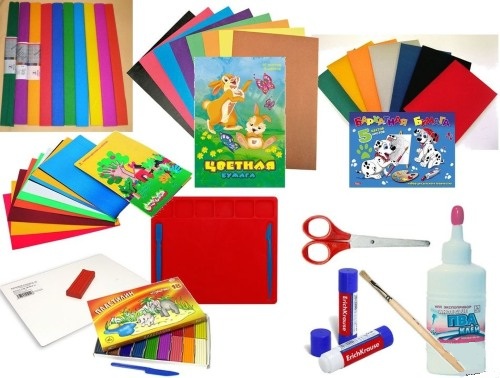
- Not only templates for further activities, but also various materials should be prepared on the table., "tools":
- scissors (light, small, comfortable for a child’s hand, necessarily with blunt ends);
- a base that will become the basis for the applique (for example, a white sheet of paper, cardboard, a wooden block);
- glue (preferably glue stick, which will not spread, spill or stain, unlike the usual liquid type);
- working material (what the applique will be made of: colored paper, fabric, cereals, foil, flowers, etc.).
Working with templates
To properly organize applique classes with children, it is important to work out every little detail, in particular templates. Applications for the youngest (3-5 years), for example, from geometric figures leave no questions regarding the creation of templates for them. In this case, it is necessary to create a drawing, indicating on it the places where the child should glue the pre-cut elements.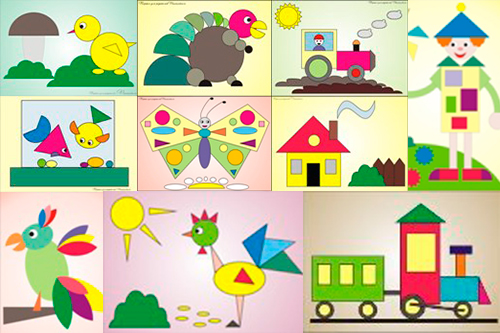
In situations with preparation for appliques for older children, certain difficulties may arise if the organizer does not have good drawing skills. The described situation is due to the need to create more complex sketches, tracing and cutting out which children will be able to obtain the necessary components of the future craft.
The algorithm for working with templates is identical for each type of application:
- create a sketch in color;
- copy the original drawing;
- cut (for children aged 3-5) or divide with bright lines (for children aged 5 and up) the copied color image into the component parts of the future work;
- glue the elements onto the prepared base.
Templates of figures for the younger group of kindergarten
Geometric shapes appliques are the most suitable a method for developing fine motor skills and creative thinking in children of the younger group of kindergarten:
- Application "Fill the jar". To work, you need to prepare a base with a drawn silhouette of a large jar (can be replaced with a plate, glass, box, etc.) and multi-colored circles of different sizes cut out according to a template (you can use several materials that differ in feel to develop tactile sensations). Children should glue the empty space in the drawing within the boundaries of the container with multi-colored "candies" in a chaotic order. The result of the work is a sketch of a jar, inside which circles of different colors and sizes are glued.
- Application "Balloon". First, you need to cut out multi-colored templates of balloons without "fasteners". Then, glue threads of the corresponding colors to the balloons onto a sheet of paper with a drawn sky (clouds, airplanes, birds, etc.). It is important to clearly explain the task to children: match the balloon with the "fastener" of the same color.
 The result is a picture of multi-colored balloons on a string, floating in the sky.
The result is a picture of multi-colored balloons on a string, floating in the sky.
Templates of figures for the senior group of kindergarten
Application of geometric shapes, addition to the plot of the picture, “composing” a picture of animals, birds, by gluing eyes, paws, wings, etc. to them – The main types of applicative activities with children aged 4-5 years:
- Application "Guess what?". For the work, you should prepare a large number of drawings of various geometric figures in advance. The child needs to cut out the details according to the templates and make a real object out of them (fruit, car, tree, etc.), gluing them together on a pre-issued base. As a result of the applicative activity, an image of all sorts of objects encountered in the child's life is obtained.

- Application "Animal". In this case, it is worth drawing templates of small components of one animal, for example, a cat, for children. The task for the kids will be to cut out and glue these parts onto paper in such a way that the resulting image of the given pet is obtained (triangles - in place of the ears, ovals - in place of the body and head, circles - in place of the eyes, and so on). The result of the work will be a glued image of the animal with the maximum number of details of appearance.
Templates of figures for the preparatory group of kindergarten
Tasks for children over 5 years old, as a rule, imply not only cutting and gluing, but also preparing a template for the applique yourself:
- Application "Friendship". It is necessary to take a clean sheet of paper, fold it in half. On the fold it is suggested to draw the outlines of half of the body of a person of any gender. The next step is to cut out the drawing. By unfolding the sheet further, the child will receive a proportional "little man". Then the child should glue the resulting people as if they were holding hands. The result is an image of a glued "round dance of friends" holding hands.

- Application "Garage". An adult asks a child to draw a garage for a car. The gate is usually depicted in the form of an arch, the roof is a triangle, and the doors are squares. Then the student cuts out the components of the future building and glues them sequentially onto a pre-prepared base for the applique. Using the same principle, you can create a car for the garage, or you can simply finish drawing it. The final applique is an image of a garage with a car inside.
Figure templates for 1st grade
Appliques made from geometric shapes are certainly possible even for schoolchildren who know how to handle scissors carefully.
Students are given complex tasks with a large number of templates - circles, polygons, the cutting of which will require strength, perseverance, and accuracy.
Applications:
- Application "Caterpillar". Children need to be given templates with drawn circles of different sizes, one small triangle and two elongated rectangles. Having cut them out and colored them, the first-grader must make a caterpillar, using all the details, where the rectangles are the caterpillar's horns, and the triangle, for example, is the mouth. As a result of the student's work, a picture with a creative caterpillar of any color, size, shape is obtained.
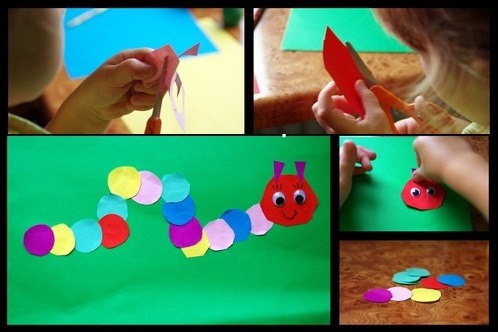
- Application "Summer cottage". To create an image of a house and its surrounding area, it is necessary to prepare templates of geometric figures based on the intended picture (square, circle, elongated and traditional rectangles - house; small circle and 2 triangles - bird, circle and elongated rectangles - sun, ovals with wavy edges - clouds; triangles, elongated rectangle - spruce; circle, elongated rectangle - tree and so on). The child, having cut out the details according to the given templates, “constructs” his summer cottage on the prepared base, which will be the final result of the applicative work.
Figure templates for grade 2
Scroll:
- Application "Flower". The outlines of future plants of a different color are attached to a single-color base. Children are asked to fill the insides of the flowers by cutting out small squares, distributing them and gluing them into the area of the corresponding color. As a result, a flower made in the style of mosaic applique should be obtained on the given base.
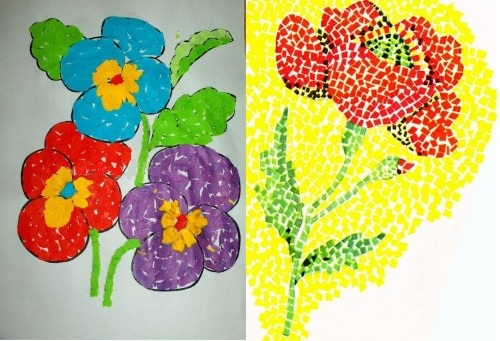
- Application "Triangles". Schoolchildren are asked to create a picture of the underwater world, using only triangles of different sizes as templates. A sheet of blue paper should be used as a basis. For the component parts of the applique, you can use not only paper, but also multi-colored felt. By cutting out triangles, students should create seaweed, fish, stones, crabs, and so on.
Shape templates for 3rd grade
Scroll:
- Application "My Family". Children need to be given templates of the component parts of the image of people of different generations, offering to finish drawing the face of a relative later. You can complicate the task by limiting the number of parts used, for example, 10 per 1 person. In this way, you can get a grandmother consisting of elementary geometric figures: three circles, like a body; with ovals instead of arms; a bun on the head; in an apron or blouse with buttons.
- Application "Clown". Children are invited to glue together a clown juggling balls from the given parts. For this applique, you need to prepare templates: 7 circles (5 - balls, 1 - head, 1 - clown nose), 5 triangles (1 - hat, 2 - suit sleeves, 2 - pants), 1 oval (torso), 1 five-pointed star (collar), 4 trapezoids (2 arms, 2 legs).
 Having finished drawing the face, children will see at the end of the lesson on their paper base a smiling clown with multi-colored balloons lined up in a row above his head.
Having finished drawing the face, children will see at the end of the lesson on their paper base a smiling clown with multi-colored balloons lined up in a row above his head.
Shape templates for 4th grade
Scroll:
- Application "Cat and mice". It is important to show children what picture they should get as a result of the work: an image of 2 mice and a cat. At this age, it is worth giving children the opportunity to obtain complex components for applique from the simplest templates of geometric shapes. To create mice, you will need: 1 oval, cutting which you can get 2 mouse bodies in profile; 6 circles of different sizes and colors (4 - ears, 2 - noses). Eyes and a tail must be finished drawing. For a cat, you need to prepare: 2 large circles (body); 3 small circles (eyes, nose); 2 triangles (ears); 2 medium-sized circles, cutting in half which you can get 2 paws and a tail. The mouth and whiskers - finish drawing.
- Application "Space"To obtain a picture of a rocket, planets and stars surrounding it, you will need templates:
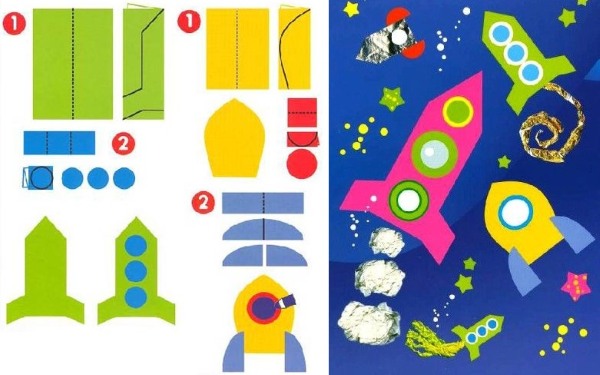 7 circles of different sizes (planets and 2-3 rocket windows); 10 stars; 1 small triangle (the "nose" of the rocket); 1 large triangle, dividing which will result in 2 parts of the "tail" of the ship; a rectangle cut into many thin strips (fire from the "tail" of the rocket).
7 circles of different sizes (planets and 2-3 rocket windows); 10 stars; 1 small triangle (the "nose" of the rocket); 1 large triangle, dividing which will result in 2 parts of the "tail" of the ship; a rectangle cut into many thin strips (fire from the "tail" of the rocket).
Application on the theme "Summer"
Applications of forests, sun, mushrooms, trees, grass, made from geometric figures of various materials, will perfectly reveal the theme of summer in the child's work:
- A thick sheet of green cardboard is used as a basis.
- Tree trunks are cut out of brown paper in the shape of a rectangle or oval.
- After gluing the trunks to the base of the applique, you need to draw branches on the plants, and then “place” fruits (apples, pears, cones) or just leaves cut out of colored paper on them.
- Many green triangles (grass) are glued to the bottom of the base.
- By adding pieces of cotton wool to the “sky”, you can get white clouds.
- Having cut out a yellow circle (sun) with elongated rectangles (rays), it is important to determine their place on the applique.
- From the oval and semicircle, mushrooms are “obtained”, which are then placed under trees.
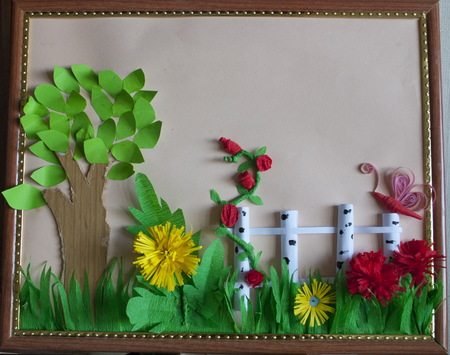
As a result of the work, the child receives an image of a sunny day with all the components of the summer period.
Application on the theme "Autumn"
When working on “autumn” appliques, you can, as an option, use natural materials:
- The child needs to cut out a vase using a template.
- Having glued the resulting “container” onto a sheet of paper, you can begin “making a bouquet”.
- Leaves of various trees, flowers, autumn grass are glued above the vase, creating the illusion of a bouquet standing in it.

An applique of geometric shapes can be made with the addition of elements of living nature: leaves, acorns, etc.
As a result of simple manipulations, the child will receive an applique illustrating the details of the autumn season.
Application on the theme "Winter"
Work with a winter theme can be done from a variety of materials: cotton wool, paper, fabric, etc. The most useful from the point of view of developing fine motor skills in children is an applique consisting of small pieces of paper. The child should not cut out these components, but tear the paper as small as possible. It is better to use a dark blue sheet of colored cardboard as a base.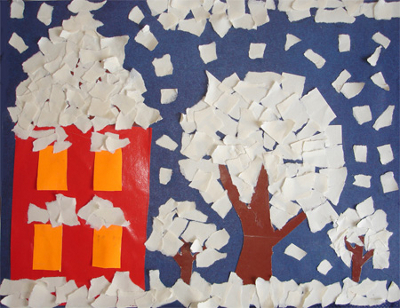
Execution:
- To begin with, children need to prepare templates of houses and trees, consisting of geometric figures. (rectangles - houses; squares - house windows; elongated rectangles - tree trunks; triangles - house roofs).
- Having glued the resulting applique pieces into place, you can begin the process of tearing the paper.
- Small pieces of white paper, obtained as a result of the work done, are randomly attached to the roof, branches, ground, depicting snowfall or snowdrifts.
As a result of the creative process, an image of a winter city is obtained on a sheet of paper.
Application on the theme "Space"
When working on a “space” applique, you can ask your child to “make up” constellations:
- First, it is necessary to select the constellation diagram that the student plans to work on.
- Templates of stars of different sizes in yellow/white are cut out.
- Contrasting details from available materials are glued onto the prepared dark base in a certain order (by the organizer or the sample) (you can use cereals that fill the outlines of the supposed stars in the sky).
- The “stars” are connected to each other by lines drawn at the final stage of the work.

The result of your creativity should be a variety of constellations of the night sky: Ursa Major/Little Dipper, Gemini, Canis Major, and so on.
Making patterns from geometric shapes
Making a pattern from geometric figures helps to master or consolidate knowledge of their names in children, develops fine motor skills, creative thinking, and imagination. This type of activity consists of gluing simple figures in a chaotic order to obtain a pattern or classifying the components by size, shape, color, and so on.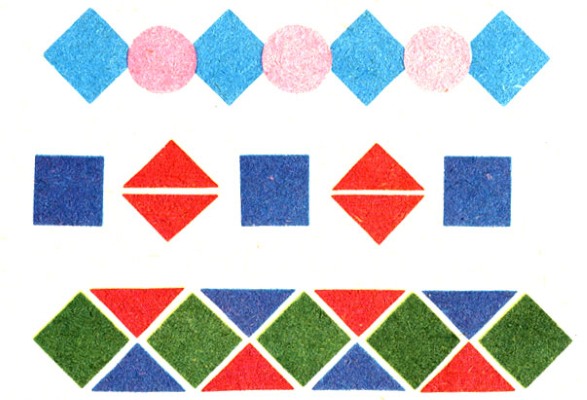
To generate interest in this type of applique in a child, an adult invites him to decorate a napkin.
Having provided the student with the templates, it is necessary to show him the sample, a copy of which should become the result of the work. An alternative to the sample can be cooperation with the teacher, where, hearing the name (color, size) of the geometric figure, previously cut out according to the template, the child should choose the very one and glue it to the indicated place.
Recommendations for conducting classes
It is important for the organizer of applique classes to remember the need to:
- properly equip the “student’s” workplace: remove unnecessary things, prepare what is necessary;
- use game techniques in classes to maintain the child’s interest;
- use a variety of materials for applications in order to best develop children's tactile sensations;
- choose a topic that matches the interests of a specific age group;
- ask the child to express his personal opinion after the work has been done for further analysis of errors in organizing the process;
- Do not limit the child’s imagination and allow him to refine the applique lesson plan as he goes along.
Applications made in the style of the simplest gluing of pictures from geometric figures, along with more complex options, should, first of all, bring joy to children.
Definitely, the "teacher" should interest children before formulating the task, praise them in the process, and evaluate the merits of the work already completed. Enjoying the classes, the child will not only develop, but also have a pleasant time in the company of peers or parents, which means that applique classes will firmly take root in his life for a long time.
Video: Geometric Shapes Applique
Applications from geometric shapes in the video:
https://www.youtube.com/watch?v=Wc0iWRbjGQE
How to create an applique with animals, learn in the video:
